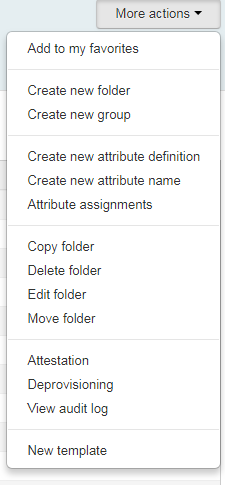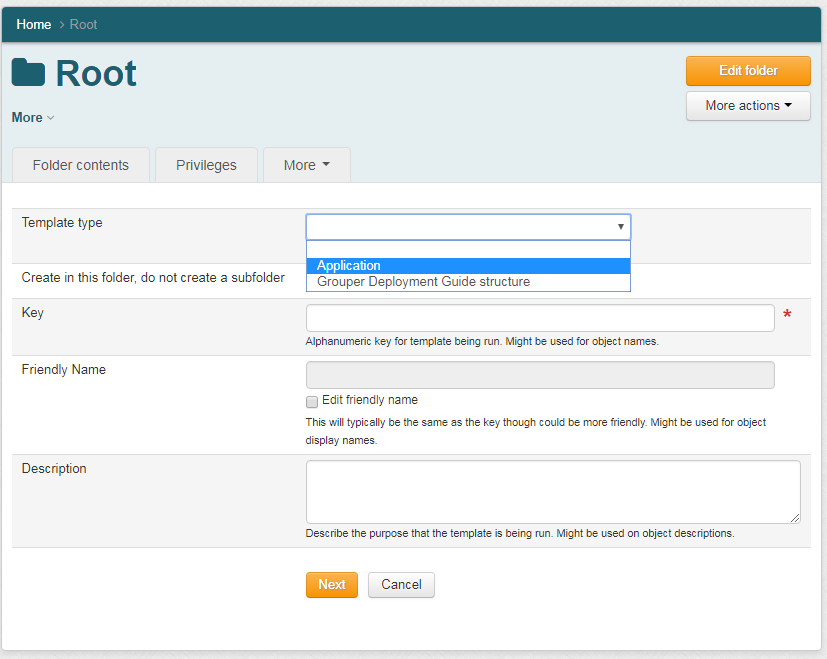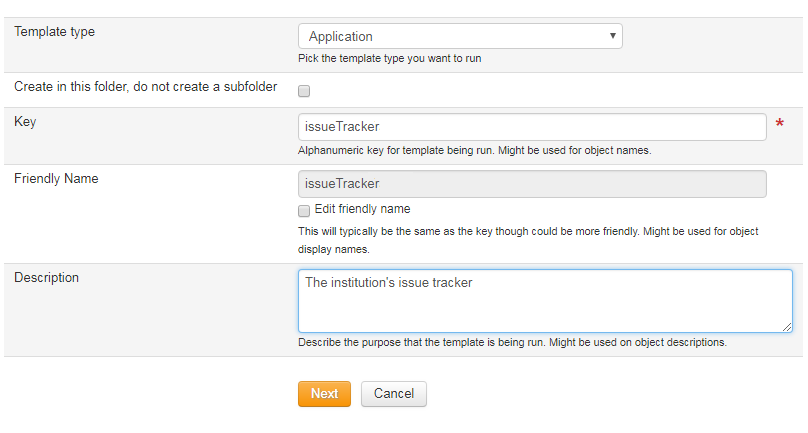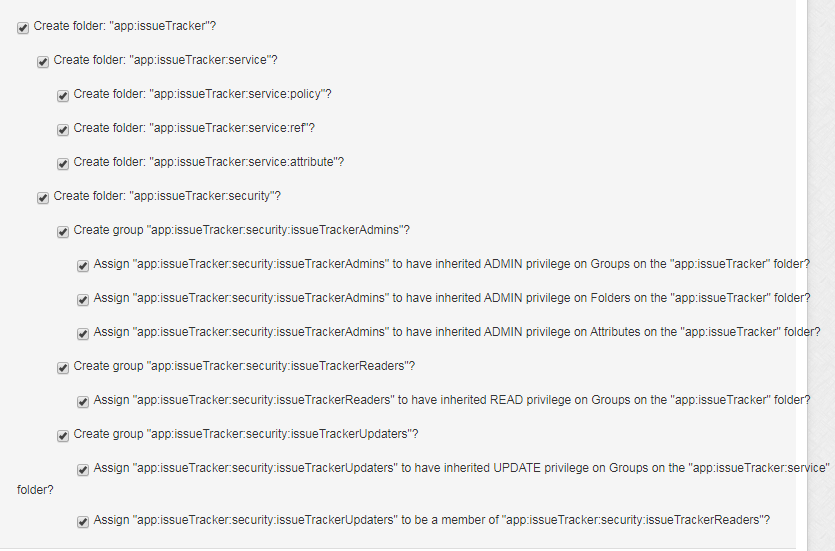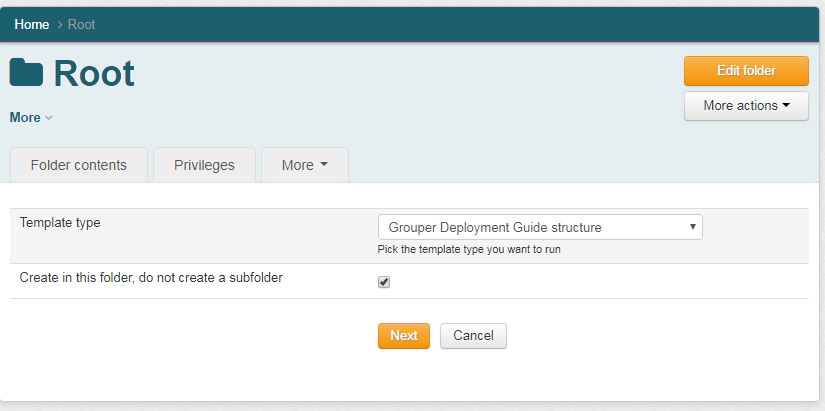Grouper UI templates are available in Grouper 2.4+.
The UI templates allow folder admins to run a function. The template creates folders and groups and assigns privileges based on inputs. This will allow Grouper users to accomplish multiple tasks at once and save time and be more consistent. The original template implementation was Java-based. In 2.5+ templates can be implemented with configuration and GSH scripts (Java/groovy).
Using the template wizard provides a convenient approach to implementing the recommendations for folder and group structure from the Grouper Deployment Guide.
Using the Template Wizard
On a folder screen, under "more actions" will be an option for "Run template"
The wizard will prompt for "Template type", which by default has "Application" and "Grouper Deployment Guide structure."
Application built-in template
The "application" option allows you to give a friendly name to an application and prompts you to set up the recommended folders for an application to be integrated with Grouper.
Grouper Deployment Guide structure built-in template
This is a convenient way to implement the recommendations for folder structure from the Grouper Deployment Guide.
Creating your own template (GSH)
See the GSH templates for examples
Creating your own template (legacy)
New templates should be configured in grouper-ui.properties, and should extend a common base class. GrouperTemplateLogicBase
- Base class
- In Java will configure options for new service
See the built-ins for examples
####################################### ############## New service template ####################################### ## use capturing group from regex as the key in the dropdown. eg: service for the below string grouper.template.service.logicClass=edu.internet2.middleware.grouper.grouperUi.beans.ui.GrouperNewServiceTemplateLogic grouper.template.tierStructure.logicClass=edu.internet2.middleware.grouper.grouperUi.beans.ui.GrouperTierStructureLogic
The wizard will prompt them for a "key" (alphanumeric), and friendly name (optional). Also the service description.
The base class should take as an input a stem, a system name extension, and optionally a friendly name extension (default to system name extension)
There should be a ui text key that describes the service (e.g. built in is "New service"). Drop down will pick which type of service
It should return a list of things it will do, as javabeans
ServiceAction
- reference back to service (which has reference to stem name, and system and display extensions)
- indentLevel (if should be indented on screen to make easier to read, e.g. under a new stem)
- type: stem, group, membership, privilege, inheritedPrivilege, attributeDef, attributeName, attributeAssignment
- arg0: e.g. for stem would be EL for the name, e.g. ${parentStemName}:${serviceSystemName}:etc. e.g. for privilege is the privilegeName
- arg1
- arg2
- externalized key for the label
- defaultChecked (true|false)
- checkSubmitted (if the checkbox was checked by user)
The UI should display the ServiceActions on the screen, with the correct indent level, and checkboxes
When submitted, if each checkbox is checked, it should do that action (if applicable). If not applicable, give a warning. The UI will pass the list of pojos, and "checkSubmitted" is set based on if the checkboxes were checked, to the base class, for a logic method, to implement the template. There should be a base class method to validate the input, pass the response JS object, and the validate method can write error messages to the screen and return true or false if valid.
Run GSH template from GSH
See the GSH attribute sync example
Run template from GSH (legacy)
Note: GSH must be run from the UI. This works in v4.1.5+
String templateType = "service";
String stemName = "test";
String templateKey = "app3";
String serviceDescription = "app3 app";
String serviceFriendlyName = "app3";
boolean createSubFolder = true;
GrouperSession grouperSession = GrouperSession.startRootSession();
Stem stem = StemFinder.findByName(grouperSession, stemName, true);
edu.internet2.middleware.grouper.grouperUi.beans.ui.GrouperRequestContainer.assignUseStaticRequestContainer(true);
edu.internet2.middleware.grouper.grouperUi.beans.ui.GrouperRequestContainer grouperRequestContainer = edu.internet2.middleware.grouper.grouperUi.beans.ui.GrouperRequestContainer.retrieveFromRequestOrCreate();
edu.internet2.middleware.grouper.grouperUi.beans.ui.GroupStemTemplateContainer groupStemTemplateContainer = grouperRequestContainer.getGroupStemTemplateContainer();
edu.internet2.middleware.grouper.grouperUi.beans.ui.GrouperTemplateLogicBase templateLogic = edu.internet2.middleware.grouper.grouperUi.serviceLogic.UiV2Template.getTemplateLogic(templateType, groupStemTemplateContainer);
templateLogic.setStemId(stem.getUuid());
groupStemTemplateContainer.setCreateNoSubfolder(!createSubFolder);
groupStemTemplateContainer.setTemplateKey(templateKey);
groupStemTemplateContainer.setTemplateDescription(serviceDescription);
groupStemTemplateContainer.setTemplateFriendlyName(serviceFriendlyName);
List<edu.internet2.middleware.grouper.grouperUi.beans.ui.ServiceAction> allServiceActions = templateLogic.getServiceActions();
// if (templateLogic.validate(allServiceActions)) { throw new RuntimeException("Not valid"); } // dont include this line for some reason
for (edu.internet2.middleware.grouper.grouperUi.beans.ui.ServiceAction serviceAction: allServiceActions) { serviceAction.getServiceActionType().createTemplateItem(serviceAction); }
